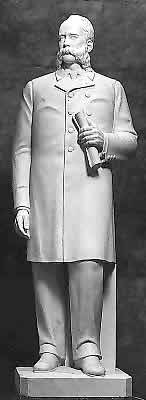Joseph Ward (1838–1889)

Joseph Ward
(NSHC statue)
Joseph Ward (May 5, 1838 – December 11, 1889) was an American educator.
Biography
Joseph Ward was born at Perry Center, New York. After attending public schools, he taught and farmed before entering Phillips Academy, in Andover, Massachusetts. He graduated from Brown University and Andover Theological Seminary. Accepting a missionary appointment, he was ordained in 1869 at Yankton, capital of the Dakota Territory, where he organized and directed church efforts. Because there were no public school funds, Ward opened a private school, which became Yankton Academy. Later given over to public control, it became the earliest high school in Dakota.
He was instrumental in the founding of Yankton College, the first collegiate-rank institution of the upper Mississippi Valley, and served as its president.[1] He played an important part in keeping school lands out of the control of eastern speculators. He was the first president of the Yankton Board of Education. He also helped establish in 1879 the Dakota Hospital for the Insane.
Ward was a leader in the movement for South Dakota statehood, serving as a delegate to the various conventions and as a member of the 1885 committee to present the petition for statehood to Congress. He drafted much of the constitution and was chairman of the committee charged with keeping the convention records. He composed the state motto ("Under God the People Rule"), and wrote the description for the Great Seal of the State of South Dakota. Bedridden and unable to attend the final constitutional convention in 1889, he died on December 11, 1889, a few weeks after South Dakota was admitted as a state.
In 1963, the State of South Dakota donated a marble statue of Ward to the United States Capitol's National Statuary Hall Collection.
External links
References
- ↑ John E. Miller, 'Setting the Agenda: Political Parties and Historical Change,' in The Plains Political Tradition: Essays on South Dakota Political Culture, Jon K. Lauck (ed.), John E. Miller (ed.), Donald C. Simmons, Jr. (ed.), Pierre, South Dakota: South Dakota State Historical Society Press, 2011, p. 78
|